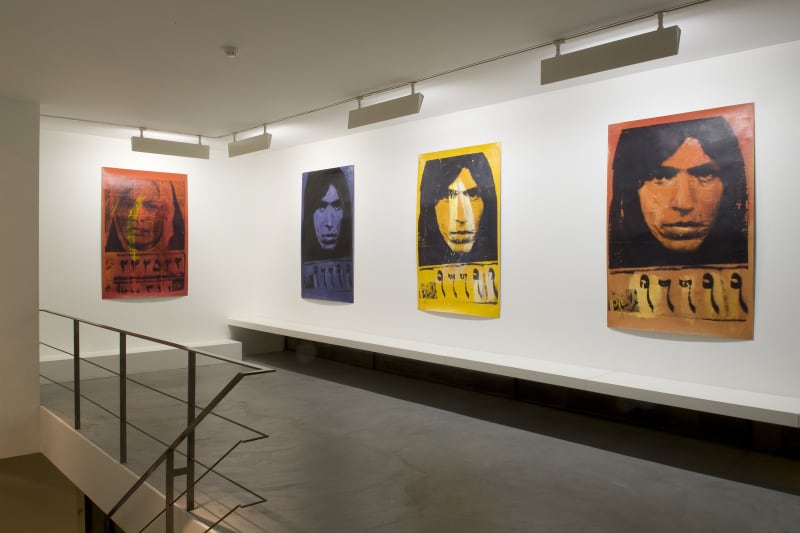Gallery Nathalie Obadia is pleased to present the first solo exhibition in Brussels of the Iranian artist Khosrow Hassanzadeh. Born in Iran in 1963, Hassanzadeh oscillates between deeply personal art, such as his work relating his experiences in the Iran-Iraq war, and homage to the interior, ornamented life of Iranian people. His work can found in the collections of the British Museum, London, The Tropen Museum, Amsterdam, the World Bank, Washington DC and he has exhibited widely including the Venice Biennale in the East-West Divan (2009), and several solo and group shows in Dubai, London and Germany.
Khosrow Hassanzadeh creates pop art in the truest sense. Kitschy evocations of his home country's public imagination abound, lit by the glint of fairy lights that evoke an atmosphere of both sanctity and plasticity. He captures a nostalgia for the past and the sentiments integral to the bazaars and traffic-plagued streets of workaday Tehran.
In this latest collection of works, Hassanzadeh takes his engagement with the popular forms and visual imagination of Iran into ceramics. 'Haft Khan' is the first time the artist has worked on ceramic tile forms of this scale, and makes reference to the abundance of such tiling in Iran. It is found in sulphurous blue hue on the domes of mosques, or sprawling mosaic-like interiors with an undulating weave of crisp forms and floral patterns. Here, Hassanzadeh composes eight 'canvases' of blue ceramic tiles. Together, the eight works form a painted fresco where broad-shouldered Pahlavan wrestlers stand alongside characters absorbed from the pages of old Persia's illuminated manuscripts.
To understand the importance of Pahlavans, it's vital to go back to the roots of the Persian imagination. The Shahnameh, the 11th century epic poem by Ferdowsi, tells the story of pre-Islamic Persia, with its rival kings, everpresent wars and heroes touched by the divine. Rostam, a Herculean figure in the poem, could almost be the Shahnameh's protagonist. His 'seven trials' sit at the heart of the poem and are entwined in Iranian phraseology (as the name of this show, 'Haft Khan', refers to), synonymous with notions of valour, courage and chivalry.
The wrestler became, for these reasons, the embodiment of Rostam in the lives of Iranians. Hassanzadeh talks about the role these powerfully built yet spiritually disciplined sportsmen would play in the community - a sort of village elder for each neighbourhood, offering advice and help to all who came to their 'zoorkhaneh' (wrestling gym).
Hassanzadeh recreates the faded patina of aging photographs of these Pahlavans on his ceramic 'canvases'. The smaller, more intricate, figures alongside the wrestlers have been lifted from the art of Persian miniature painting, used to illuminate poetry such as the Shahnameh. This combined imagery represents the shared adoration of Iranians for wrestlers and the sentiments of the epic poems that gave Iran its national identity.
Yet the title of these works, 'Haft Khan', and its relationship with the trials of Rostam, sets a tone for Hassanzadeh's work. As Iran faces its recent upheavals, the struggle that 'Haft Khan' implies is pointed to. By placing the pieces on tiles, synonymous with the decoration found in mosques, he makes reference to an almost devotional struggle for the Pahlavan ideals of freedom, chivalry and righteous code of conduct that can be found in the people of contemporary Iran.
Accompanying these works is a series of silkscreen tapestries that take the same faded photographs of the Pahlavan but surround these with elegant yet frenetic calligraphy of the same repeated phrase, 'Ya Ali!' The phrase is often used to request luck before a bout by Pahlavan wrestlers, but has deep connections with Sufi Islam, a mystic form of the religion that is associated with the spiritual dedication of the wrestlers and the whirling Dervishes who dance themselves into trance-like connection with God. Hassanzadeh's style of calligraphy mirrors that whirling effect of the Dervishes.
Alongside this, the artist presents a selection of works from his 'Ready To Order' series, in which he creates his own versions of the small box-like mementos found in shrines around Iran. The mementos, filled with photographs and small objects from a person's life, are usually created in dedication to sons lost as martyrs or prominent religious figures. But here, Hassanzadeh has scoured the bazaars of Tehran to create his own readymade tribute to the figures that were swept away in the tide of the Islamic Revolution. Famous gymnasts, who captured the imagination of the country, or since banned singers such as Javad, who lives on as a name synonymous with kitsch, are presented as cutouts framed in a nostalgia-tinged tangle of twinkling fairylights, blooms of orange garlands, and fabulously garish fantasy backgrounds. These kitsch-soaked objects are part-sculpture, part-installation and capture the public nostalgia felt towards the icons of pre-Revolution.
Khosrow Hassanzadeh: "Haft Khan"
Past exhibition
